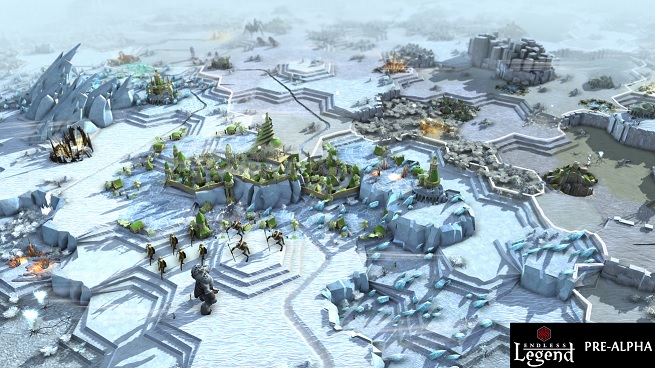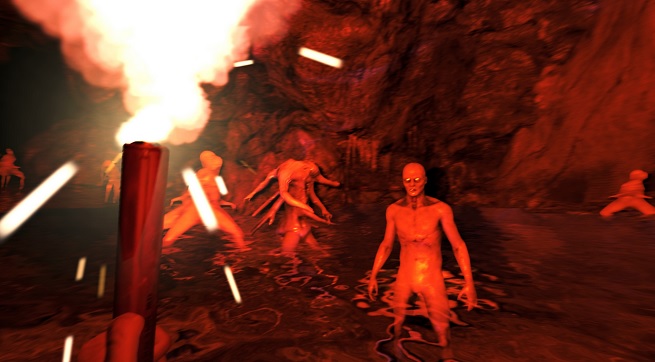GamesBeat: This is a new sector for you guys to go into. Why did you decide to go into this layer of the business?
Helgason: It’s this question that we see many of our customers not just living by, but dying by. They have a hard time getting the right traffic to their games.
GamesBeat: There are, what, maybe 400 companies in this middleman space? They’re all trying to sell a different solution to the gamemakers who are wondering what the solution is for getting traffic and downloads. Why have Unity as one more company in the space?
Helgason: It’s fair to say that of the 400, we picked the one we were most passionate about in Everyplay. It’s a free service. It’s not really advertising. It’s not really a lot of these things. It’s a pure mechanism for players who are playing the game to share their experience. From that, games get additional traffic. It’s a beautiful thing. It’s well-coded by a small Finnish team. There’s a lot of brilliant people in Finland for whatever reason.
We felt this was a solution we could bring out to our customers that will help them. We already saw it, before we acquired them, driving traffic to cool games. Also games that are premium downloads, or DLC-based rather than in-app purchase-based, which we think is underserved. It’s something that needs more power in their ecosystem. It doesn’t invalidate the 399 other companies, of course.
GamesBeat: Do you see Unity as a consolidator in the space?
Helgason: Only in the sense that, something like Everyplay, it was a fragile, underfunded company. We were afraid that they would get bumped around. So, in that sense, by bringing it into a bigger ecosystem and giving it the boost that we could give them, yes, that helps. But we’re not a consolidator. We don’t think we should pick winners in every category.
GamesBeat: What is your approach to mobile?
Helgason: It’s been very simple. The tool already exists. We made it export to iOS and then export to Android and Windows Mobile and Blackberry. People could build for the platforms they cared about.
GamesBeat: This stuff used to be really hard to do, right?
Helgason: It depends. If you want to be not so generous, or more generous to the games industry, the games industry has always had tools for themselves. This industry possesses some of the smartest developers in the world. Big companies in particular could always figure this out. But here came a tool that was as good as the best of them and available to the rest of the people that didn’t have these teams, didn’t have the experience, or didn’t have the time and money to spend on building their own tech. That’s where we came from.
It turns out that it’s also cost-effective for some of the big companies with tech to buy our stuff, because it saves them costs and allows them to deploy their best engineers on actually building games, which is the real [difference-maker] these days.
GamesBeat: Is it at this point where it’s trivial matter for you to add another platform?
Helgason: I wouldn’t say it’s trivial. The cross-platform aspect of Unity—we talk about mobile platforms, but we support between 15 and 20 actual platforms, including the consoles and PC and web and WebGL now. It’s not trivial to do all this stuff at the same time. In fact, it’s kind of the opposite. We had to innovate a lot to make this possible.
GamesBeat: This is why you have 400 people.
Helgason: It’s definitely a big part of it. It’s not easy to do this.
GamesBeat: Your competitors, like Epic and Crytek, came from the top down, in high-end and console games. You’ve bubbled up from the bottom, in a way. Can you talk about that dynamic?
Helgason: It’s a good question. They came from a world where they had their own studios and primarily worked on their own games. Then they commercialized their engines. That just wasn’t our path. We built our own software, but we decided that the other path was more interesting to us.
It’s so different, how we think about the world. At some point we said, “We’re going to be cheaper,” and then we said, “We’re going to be cheap and free.” In 2009 the other guys went free as well, but they failed to get traction from that. They’re trying to revamp their offerings now, with subscription and the backend, and updated tools that are better than they used to be.
Bizarrely enough, it’s not showing up in our numbers at all. Nobody actually left, it seems. Our numbers are just as stable as they’ve always been. But it’s interesting to see the industry being more competitive now than it used to be.
GamesBeat: With their base price, they’re trying to undercut you.
Helgason: They actually went up in price, in a way. Now Unreal has a five percent backend, which arguably makes it the most expensive engine on the market. It doesn’t really matter. I won’t go into the math.
GamesBeat: What are you hoping for over time, in the next year or two years? What do you want Unity to be, and the ecosystem as well?
Helgason: I want Unity to be the same as it is, serving developers as well as we can with great tools and services. We want to focus on their success. That’s Unity. I don’t see us changing. What I want for the industry is a few things. I want more power to premium games and storytelling games, games that are more culturally relevant than the hardcore-est of hardcore freemium titles. Apple and Google support that to some level, and I think they’ll support it more.
We want to support it more with things like Everyplay, where instead of seeing an icon in an app store, you actually see a video of what the game offers. That gives a lot of power to people with compelling, deep experiences. Now, most games seem to get downloaded through an icon or a name, which is hard to put a value on. It’s part of why free games dominate so harshly.
Otherwise, we want to follow where the ecosystem takes us and support the needs of developers.
GamesBeat: Is there a way you think you can get into the heart of what people consider the traditional game industry, the home console business?
Helgason: We are there, in the sense that a lot of console games are being built with Unity now. We partnered with the big platforms. Unity’s free for Xbox One and Wii U. Sony’s sponsored licenses for PlayStation. A lot of titles are coming out from first parties. So we’re definitely there. Also some large PC franchises are using Unity.
GamesBeat: What about micro-consoles? Are you optimistic about that category?
Helgason: I want to be. I want to be optimistic about everything. The more opportunities there are for developers, the better. I guess there are questions about Ouya now. I haven’t followed the news too closely. There are lots of rumors.
It’s great if these devices have traction, because again, people clearly want to play games in a lot of places. It’s tough for micro-consoles to compete with mobile, though. This is just a device people have in their pocket. To do an additional purchase, I think, is a tough sell to everyone except the more hardcore audience, which is already buying these wildly more powerful consoles.
GamesBeat: Now that you’re in services, what do you think is going to happen to solve the problem that mobile game companies have with discovery and user acquisition?
Helgason: I don’t know. We’re going to help a little bit, and maybe a lot. We acquired Playnomics, which is a sort of—they do analytics, but the goal of it is CRM, managing your users. Predictive analytics and making decisions based on behavior about how you should deal with your players. We’re going to do everything we can to give great tools like that to developers.
Besides that, I think a lot of it is on the app store managers to elevate games that are really good. They already do a decent job of it. But not just the people who can buy their way through the rankings. All my intuition is screaming that this is going to happen, and then we’ll have a healthier industry in a year or two.
GamesBeat: What do you think the quality level will be like in a year or two for the best mobile games?
Helgason: It blows my mind every year. The quality, the polish goes up so dramatically. Just in our world, which is a sort of annex to the whole mobile industry—we have awards every year for the best games in our ecosystem. At some point I said, “Every game that was nominated this year would have won every award last year.”
That’s how I feel about the whole industry, or at least the mobile ecosystem. It’s going up at a staggering rate. The devices get more powerful. Developers get smarter. The ecosystem gets bigger so they can afford to invest more. The tools get better. People get great at making games for mobile. Three years ago, nobody had more than a couple of years’ experience in mobile. Now a lot of people have five-plus years. There are many sharply inclining lines layered on top of each other.
GamesBeat: Knowing what you guys know about the game business and gamemakers, what sort of visibility is most interesting to you, that you get from this? What’s the direction of the game industry right now? What kind of analytics information do you absorb that you can direct people with?
Helgason: It’s just in the biggest lines, in that—We see everything working. We see two-person teams building fantastic games and making enough money that they can pay the bills for several years, which enables them to build wonderful studios. We see every type of thing working, and of course also not working.
The possibilities are so wild. The industry, or at least the press, can be a bit myopically focused on one company making $1 billion. There’s a lot of people making $1 million to $5 million, which is incredible, if you’ve invested only a couple hundred thousand. We see that everywhere. The main thing is just the continuing explosion of opportunity. That’s the top line for us.
You may have heard me say this before, but if you go back 15 years, if you had a product you wanted to show the world of any kind, the biggest way to take that to the market would be prime time U.S. television. You might get noticed by 100 million people if you spent a lot of money. Now you can take a quality offering to a few app stores and marketplaces and reach more than 2 billion people. In five years that’ll be 4 billion people. It’s 40 times larger in the space in 20 years. It’s liquid. There’s no particular friction in it except the competition with others, which is significant. But we keep seeing amazing things get a lot of traction. To be part of the industry in this time is mind-blowing.
GamesBeat: It’s interesting to see user-generated content grow like crazy. I wonder, is there an opportunity for you guys in that space? Right now, you’re mainly helping professional developers. There are also players who want to create for these games.
Helgason: There some really amazing games that solicit user-generated content. Stair Dismount had that on Steam. We’ve not seen a lot of user-generated content on mobile, because the tools to create are still kind of wonky there. But people will figure it out. With the traction user-generated content has on other platforms, it’s impossible that nobody’s going to be successful with that in the next few years.
Our main job sometimes, especially with development features, is just to get out of the way and make it possible for developers to do. It’s possible and it’s easy, so we’re just not in the way. It’s going to be exciting when that happens.




